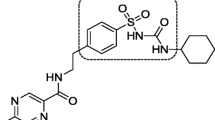Summary
Since little is known of the number and types of binding sites on α1-acid glycoprotein (AAG) and because drug-drug protein binding interactions often fail to fit a simple model, a study of the effect of 9 known AAG binding drugs on lidocaine free fraction (LFF) was performed. Serum was obtained from 10 healthy males, pooled and various concentrations (from 0.15 to 1 000 µg/ml) of amitriptyline, bupivacaine, chlorpromazine, disopyramide, imipramine, meperidine, nortriptyline, propranolol and quinidine were added. LFF was determined by equilibrium dialysis at an initial lidocaine concentration of 2.0 µg/ml. LFF increased from 0.30±0.019 (mean ± SD) in the absence of displacing agents to maximum values ranging from 0.59 (nortriptyline) to 0.73 (bupivacaine). Plots of LFF vs. the logarithm of displacing drug concentration yielded simple sigmoidal curves in all cases. LFF was increased 50% by an initial bupivacaine concentration of 6.0 µg/ml with all other drugs requiring more than 10 µg/ml to increase LFF to that extent. Lidocaine binding in a 4.5 g/dl albumin solution was unaffected by concentrations of quinidine, meperidine, nortriptyline and bupivacaine up to 200 µg/ml. Addition of AAG to serum reduced LFF as expected. A plot of the reciprocal of bound drug concentration vs. the reciprocal of free drug concentration in the presence and absence of quinidine suggested a competitive binding interaction. These data indicate that the binding interactions between lidocaine and the various displacing compounds are not significantly complicated by cooperative effects and that, with the possible exception of bupivacaine, displacement of lidocaine by any of these drugs is unlikely to be of clinical significance.
Similar content being viewed by others
References
McNamara PJ, Slaughter RL, Pieper JA, Wyman MG, Lalka D (1981) Factors influencing serum protein binding of lidocaine in humans. Anesth Analg 60: 395–400
Routledge PA, Barchowsky A, Bjornsson TD, Kitchell BB, Shand DG (1980) Lidocaine plasma protein binding. Clin Pharmacol Ther 27: 347–351
Edwards DJ, Lalka D, Cerra F, Slaughter RL (1982) Alpha1-acid glycoprotein concentration and protein binding in trauma. Clin Pharmacol Ther 31: 62–67
Routledge PA, Stargel WW, Wagner GS, Shand DG (1980) Increased alpha1-acid glycoprotein and lidocaine disposition in myocardial infarction. Ann Intern Med 93: 701–704
Piafsky KM, Borga O, Odar-Cederloff I, Johansson C, Sjöquist F (1978) Plasma protein binding of propranolol and chlorpromazine mediated by disease-induced elevations of plasma alpha1-acid glycoprotein. N Engl J Med 299: 1435–1439
Lima JJ, Boudoulas J, Blanford M (1981) Concentration-dependence of disopyramide binding to plasma protein and its influence on kinetics and dynamics. J Pharmacol Exp Ther 219: 741–747
Piafsky KM, Borga O (1977) Plasma protein binding of basic drugs. II. Importance of alpha1-acid glycoprotein for interindividual variation. Clin Pharmacol Ther 22: 545–549
Nation RL (1981) Meperidine binding in maternal and fetal plasma. Clin Pharmacol Ther 29: 472–479
Sager G, Nilsen OG, Jacobsen S (1978) Variable binding of propranolol in human serum. Biochem Pharmacol 28: 905–911
Nilsen OG, Leren P, Aakesson I, Jacobsen S (1978) Binding of quinidine in sera with different levels of triglycerides, cholesterol, and orosomucoid protein. Biochem Pharmacol 27: 871–876
McDevitt DG, Frisk-Holmberg M, Hollifield JW, Shand DG (1976) Plasma binding and the affinity of propranolol for a beta receptor in man. Clin Pharmacol Ther 20: 152–157
Huang JD, Oie S (1982) Effect of altered disopyramide binding on its pharmacologic response in rabbits. J Pharmacol Exp Ther 223: 469–471
Wilkinson GR, Shand DG (1975) A physiological approach to hepatic drug clearance. Clin Pharmacol Ther 18: 377–390
Vallner JJ (1977) Binding of drugs by albumin and plasma protein. J Pharm Sci 66: 447–465
Solomon HM, Schrogie JJ (1967) The effect of various drugs on the binding of warfarin-14C to human albumin. Biochem Pharmacol 16: 1219–1226
Rawlins MD, Collste P, Bertilsson L, Palmer L (1975) Distribution and elimination kinetics of carbamazepine. Eur J Clin Pharmacol 8: 91–96
Nilsen DG (1976) Serum albumin and lipoproteins as the quinidine binding molecules in normal human sera. Biochem Pharmacol 25: 1007–1012
duSouich P, Lalka D, Slaughter RL, Elvin AT, McLean AJ (1979) Mechanisms of non-linear disposition kinetics of sulfamethazine. Clin Pharmacol Ther 25: 172–183
El-Gamel S, Wollert U, Muller WE (1982) Optical studies on the specific interaction of dipyridamole withα 1-acid glycoprotein (orosomucoid). J Pharm Pharmcol 34: 152–157
Jusko WJ, Gretch M (1976) Plasma and tissue protein binding of drugs in pharmacokinetics. Drug Metab Rev 5: 43–140
Lalka D, Vicuna N, Burrow SR, Jones DJ, Ludden TM, Haegele KD, McNay JL (1978) Bupivacaine and other amide local anesthetics inhibit the hydrolysis of chloroprocaine by human serum. Anesth Analg 57: 534–539
Moore DC, Mather LE, Bridenbaugh PO, Bridenbaugh LD, Balfour RI, Lysons DF, Horton WG (1976) Arterial and venous plasma levels of bupivacaine following epidural and intercoastal nerve blocks. Anesthesiology 45: 39–45
Kuhnert PM, Kuhnert BR, Stitts JM, Gross TL (1981) The use of a selected ion monitoring technique to study the disposition of bupivacaine in mother, fetus and neonate following epidural anesthesia for cesarian section. Anesthesiology 55: 611–617
Lesko LJ, Ericson J (1980) Simultaneous determination of bupivacaine and 2,6-pipecoloxylidide in serum by gas-liquid chromatography. J Chromatogr 182: 226–231
Author information
Authors and Affiliations
Rights and permissions
About this article
Cite this article
Goolkasian, D.L., Slaughter, R.L., Edwards, D.J. et al. Displacement of lidocaine from serumα 1-acid glycoprotein binding sites by basic drugs. Eur J Clin Pharmacol 25, 413–417 (1983). https://doi.org/10.1007/BF01037957
Received:
Revised:
Accepted:
Issue Date:
DOI: https://doi.org/10.1007/BF01037957




